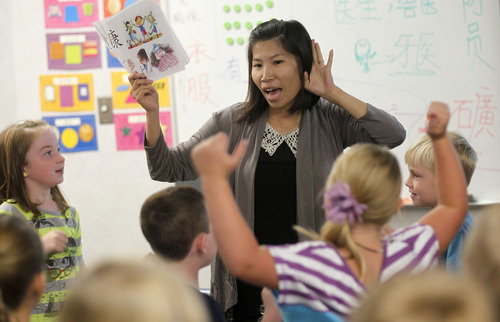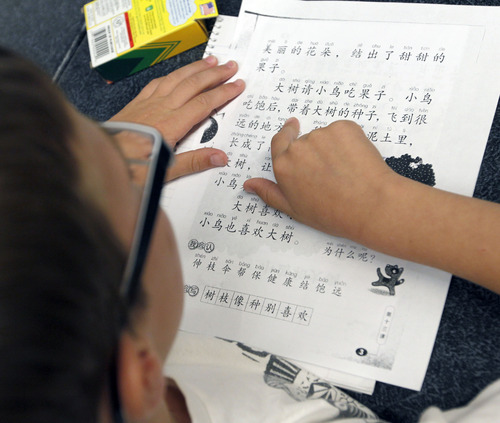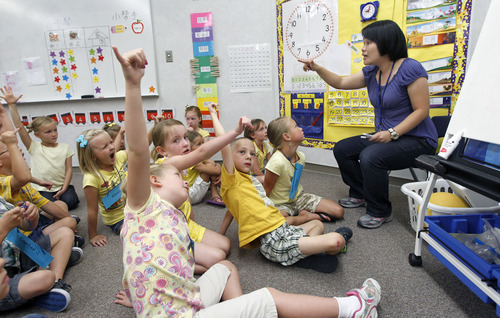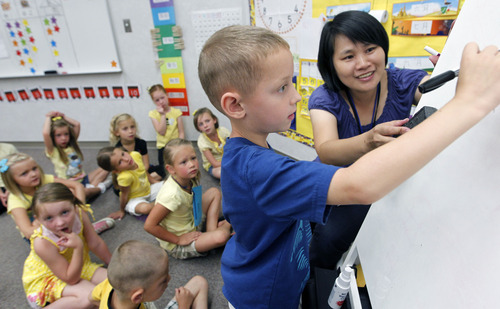This is an archived article that was published on sltrib.com in 2012, and information in the article may be outdated. It is provided only for personal research purposes and may not be reprinted.
Riverton • It's only the second week of school, but first-graders at Foothills Elementary in Riverton can count to five in Chinese.
They can stand up and sit down when teacher Pei Chi Chang commands them in her native language. And when visitors peek into the classroom, students offer an enthusiastic "Ni hao!" instead of the English "Hello."
"As you can see, they can already follow simple orders like 'sit down for me, please,' " said Chang, who arrived in Utah two weeks ago from Taiwan to teach in one of the Jordan School District's 10 dual immersion language programs.
"To learn a language at an early age is always good, especially when learning the pronunciation part. We know that China is a very powerful country and Chinese is a tool. I'm hopeful in the future the kids can use Chinese as a tool to get them anywhere."
Chang's beliefs are emblematic of a philosophy held by Utah parents, who are increasingly enrolling their children in dual immersion programs offered at 78 elementary schools statewide.
This year, approximately 14,000 children will start school in dual immersion programs in Utah, taught in Spanish, French and Chinese. Portuguese will be offered for the first time in 2012, provided by programs at three elementary schools in the Alpine, Murray and Provo school districts.
Demand is greater than the number of chairs open for students, said Gregg Roberts, world-language specialist and dual language-immersion specialist at the Utah State Office of Education.
The Jordan School District has expanded its dual immersion programs to 10, with waiting lists at several schools.
Roberts attributes the interest to the savviness of parents, who know there are economic benefits for people who can speak another language.
State Superintendent Larry Shumway has set a goal to have 30,000 students enrolled in dual immersion programs at 100 elementary schools by 2015, Roberts added.
To prepare students for future jobs, "We must educate students who are multi-lingual and globally confident," Roberts said. "It takes many, many years of hard work to learn a language at a business-quality level."
—
A new kind of school day • Students are taught entirely in the new language they are learning for half the day. The second half is spent learning in English.
While hearing a foreign language can be bewildering and a little scary for a 7-year-old on the first day of school, students need to look no further than their counterparts down the hall to see just how quickly fluency can emerge.
At Foothills Elementary, first-graders in Chang's class learned how to ask for a drink of water on Wednesday.
Third-graders in Yufang Huang's class were spouting new vocabulary words and reading aloud from worksheets and books written exclusively in Chinese.
"They can do a lot," said Huang, who like Chang arrived in Utah from Taiwan through a program designed to recruit language teachers. "With Chinese, their whole world will change. They make friends in different cultures; it boosts their confidence."
Nationwide, there are Chinese programs at 75 elementary schools, and a third are in Utah, Roberts said.
He credits former Gov. Jon Huntsman, also a former U.S. ambassador to China, with touting the importance of learning about Chinese language and culture.
Many students enrolled in Chinese dual immersion programs were at Utah Valley University this week for a two-day camp, where they dined on Chinese food and enjoyed cultural activities. Students mingled with like-minded children and teachers, including educators from abroad who have relocated to Utah to help meet the need for language instructors.
In the Jordan School District, three guest teachers recently arrived from Taiwan and another three from France will teach after they obtain a one to three-year visa, said Carolyn Gough, the district's world language consultant.
The teachers live with American host families while they do tasks such as finding an apartment, car and setting up a bank account.
—
More programs ahead? • Only 125 first-graders were enrolled in dual immersion programs in the Jordan School District in 2008, the first year they were offered.
This year, 600 district first-graders are enrolled in 10 programs — five Spanish, four Chinese, and one French. Welby Elementary in South Jordan and Herriman Elementary are offering programs for the first time this year.
Gough predicts the number of programs will grow.
"A person who knows a second language is always going to be able to get a job or interact with another culture," said Gough. "We have a lot of culturally sensitive people in Utah. Whether they spoke a second language themselves, were a native speaker of another language or came to learn a language through church service ... they recognize the value of a second language."
To help add Portuguese programs, the state received grants from the Department of Defense, which has identified it as a language needed to communicate in Brazil and many African countries.
Utah is home to about 30,000 people fluent in Portuguese, Roberts said, including 15,000 people from Brazil and another 15,000 people who learned the language while serving a mission for The Church of Jesus Christ of Latter-day Saints.
With Brazil one of the top LDS missionary destinations, the community is interested in children learning Portuguese, Roberts said.
A second language will benefit children in the future, said Barbara Yost, principal at Foothills Elementary.
"By January, they'll be talking and writing," she said, pointing to Chang's first-graders, who were on day five of learning Chinese Wednesday. "It's a huge advantage for our community."
mrogers@sltrib.comTwitter: @mrogers_trib —
How dual immersion programs get their start
Dual immersion language programs are driven by parent requests, first made to school community councils. They are considered by school and then district administrators.
Officials must weigh factors that include where students will attend middle and high school programs.
The state will consider new programs as ideas are presented by school districts, said Gregg Roberts, dual language immersion specialist at the Utah State Office of Education.
Last spring, low interest scuttled a plan to offer a German program in Provo, Roberts said.









